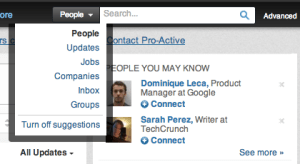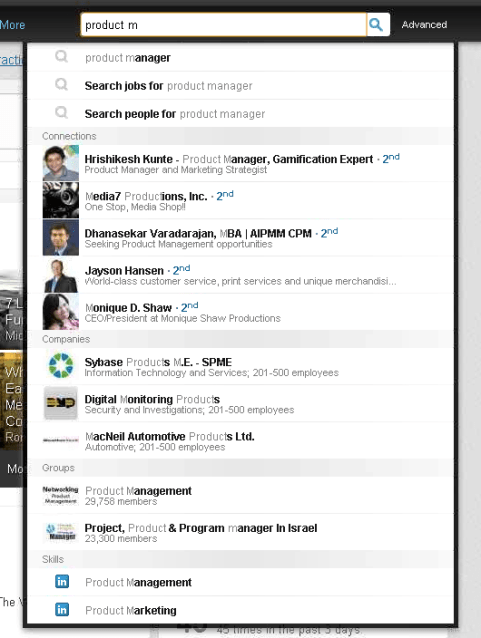Professional social network LinkedIn today is announcing an upgrade to its search features — one of the first big overhauls that the search function has had in years, with new features including improved autocomplete and suggested phrasing by way of a new algorithm; unified searches across different product categories; and an improved ability to save searches. Facebook-style “third pillar” Graph Search it may not be — don’t mistake this for a window out to the wider Internet (for now at least) but with this upgrade, LinkedIn is telling us that its search window is part of the company’s larger strategy to improve engagement and time spent using its site, crucial for its wider business model based both on advertising and premium services.
Brad Mauney, product lead for LinkedIn overseing identity products and search, describes the new search as more than just an upgrade to what was there before: it’s the next step in how LinkedIn hopes to get more functionality and usability into its platform as it continues its transformation away from being a simple database and point-to-point communication platform, and into more of a social network.
“We’ve moved to a next-generation search platform that will allow us to do more interesting iterations as we bring more content into the site, and gett into the path of more personalized experiences, utilizing everyting that LinkedIn has to offer,” he said. This brings to mind where a company like Pulse could fit into the mix, along with potentially other acquisitions in the social media space.
LinkedIn says that the new search is being turned on globally from today, with no waiting lists, but with a staged rollout. But it will not work on mobile platforms initially, according to Mauney. There, your searches will remain limited to people.
The search feature is already a popular way for people to use the site: LinkedIn says that last year there were some 5.7 billion searches done on LinkedIn. The idea now is to make that a less bouncy and more sticky experience that encourages users to explore other parts of the site that they may not normally use.
 That’s starting with a fairly simple tweak. In the past users selected categories to search in a drop-down menu, with categories including people, status updates from your contacts, jobs, companies, your inbox and your groups. Now, by default, your searches will be across the whole of LinkedIn.
That’s starting with a fairly simple tweak. In the past users selected categories to search in a drop-down menu, with categories including people, status updates from your contacts, jobs, companies, your inbox and your groups. Now, by default, your searches will be across the whole of LinkedIn.
This, of course, will mean that you will see more content, and be more encouraged to click through to look at more results.
Those searches, meanwhile, are also going to be powered by stronger algorithms developed by LinkedIn to better guess what it is that you would like to find. The autosuggest feature, Mauney says, will learn from your past browsing and searching activity on the site to create an increasingly customized set of autocompleting terms.

As with before, LinkedIn is putting more emphasis on results that fall within your own network — with that so-called “professional graph” extending not just into people contacts but also potential job searches, giving you results for open positions where you may have connections who can help open a door.
While these searches are being aimed at LinkedIn’s 200 million+ users, there are also tweaks that it is making both to cater to power users, and to encourage those using the free service to perhaps consider a premium subscription. Saved searches are now significantly easier to organise and use, and more parameters to specify what it is that you would like to find. Making the saved searches easier to use will potentially encourage people to use them more, and there is where LinkedIn may subtly be trying to attract more premium users: free saved searches are limited to only three unless you are a paying LinkedIn member.
Asked whether the new search is LinkedIn’s answer to Facebook’s Graph Search, Mauney draws a parallel between what Facebook has created and what LinkedIn has always tried to do. “LinkedIn has always been focused on you and your network in terms of how results get surfaced,” he noted. “It’s always been a function of your connections and your connections’ connections. We are very excited to see the changes in the industry of more companies focusing on the power of one’s network to surface results.”
But he also acknowledges that Graph Search has raised LinkedIn’s game, too. And in its own way, it provides another route to luring people away from using basic browser searches. “We’re excited to see the industry shift because it changes a particular user’s mindset. It’s not just about a seamless search box on Google but it’s about using the power of one’s network to search for relevant and professsional network results.”
That’s not to say that Google does not remain a hugely important search platform for LinkedIn, which makes all users’ public profiles searchable on all browsers, which becomes an significant way for people to enter LinkedIn altogether. “We have invested quite a bit in the SEO ranking on Google,” he said. “The reason we rank so highly is because that is what people are clicking on they are very likely to click on that first because that is your profile.” The key now, though, is to keep people from bouncing away again once they’ve seen what they wanted to see.
Two big missing pieces for this search upgrade, however, are the fact that mobile is not included, and nor are results from the wider web — unless someone in your network has happened to share that content into LinkedIn. The walled garden’s walls remain fairly high.
LinkedIn only says that mobile is “something that we are looking into,” with the apps still only allowing users to search people but not within other categories.
Ultimately, the search upgrades are very much aimed at improving discovery within LinkedIn itself, and because of that, Mauney would not comment on whether LinkedIn had plans to extend search into web results as well. Now that LinkedIn’s upgraded its search this is where attention should turn: Regardless of whether LinkedIn offers more web content directly or via a platform like Pulse’s news aggregation, content will continue to be the piece that LinkedIn has to develop to make its search more attractive, and beyond simply a place to look for your next job.
